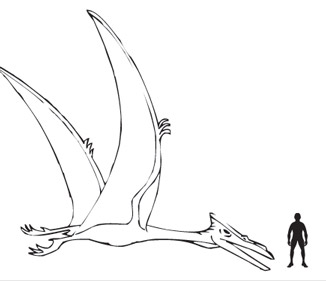Quetzalcoatlus – From the Feathered Serpent God of the Aztecs
Quetzalcoatlus northropi
The biggest pterosaurs known are those of the family Azhdarchidae, the largest of them all (at least the one scientifically named and described), is Quetzalcoatlus northropi. The first fossils of this huge flying reptile were found in Texas in 1971. Unusually for a large pterosaur, the fossils were not found in marine strata, but in sediment laid down inland. Named after the feathered serpent deity of the Aztecs, this huge creature is estimated to have had a wingspan in excess of 11 metres. It is regarded by scientists as being the largest flying animal ever.
An Illustration of Quetzalcoatlus

Picture credit: Everything Dinosaur
Quetzalcoatlus was one of the last pterosaurs (flying reptiles), not a dinosaur but closely related to the Dinosauria sharing a common ancestor with them from the archosaurs. Although huge, it has been estimated that these animals weighed less than 100 kilogrammes. Pterosaurs like Quetzalcoatlus had evolved a number of weight saving devices to assist flight, such as a lack of teeth in the jaws and a skull so thin and light it has been described to us by scientists as resembling expanded polystyrene. The bones had a lot of air spaces in them, and although strong, the bones were exceptionally light. Few bones such as these survive the fossilisation process, so even after nearly 40 years after its first discovery few fossils of Quetzalcoatlus have been found.
To view a scale model of Quetzalcoatlus and other flying reptile models available from Everything Dinosaur: Dinosaur, Pterosaur and Prehistoric Animal Models.
The extinction of the pterosaurs at the end of the Mesozoic was not a sudden event. The fossil record indicates that these amazing and magnificent animals were decreasing in their diversity in Late Cretaceous times. Only a few types of pterosaur survived into the Maastrichtian faunal stage, it seems that these creatures were already declining before the mass extinction event the marked the end of the Cretaceous.

